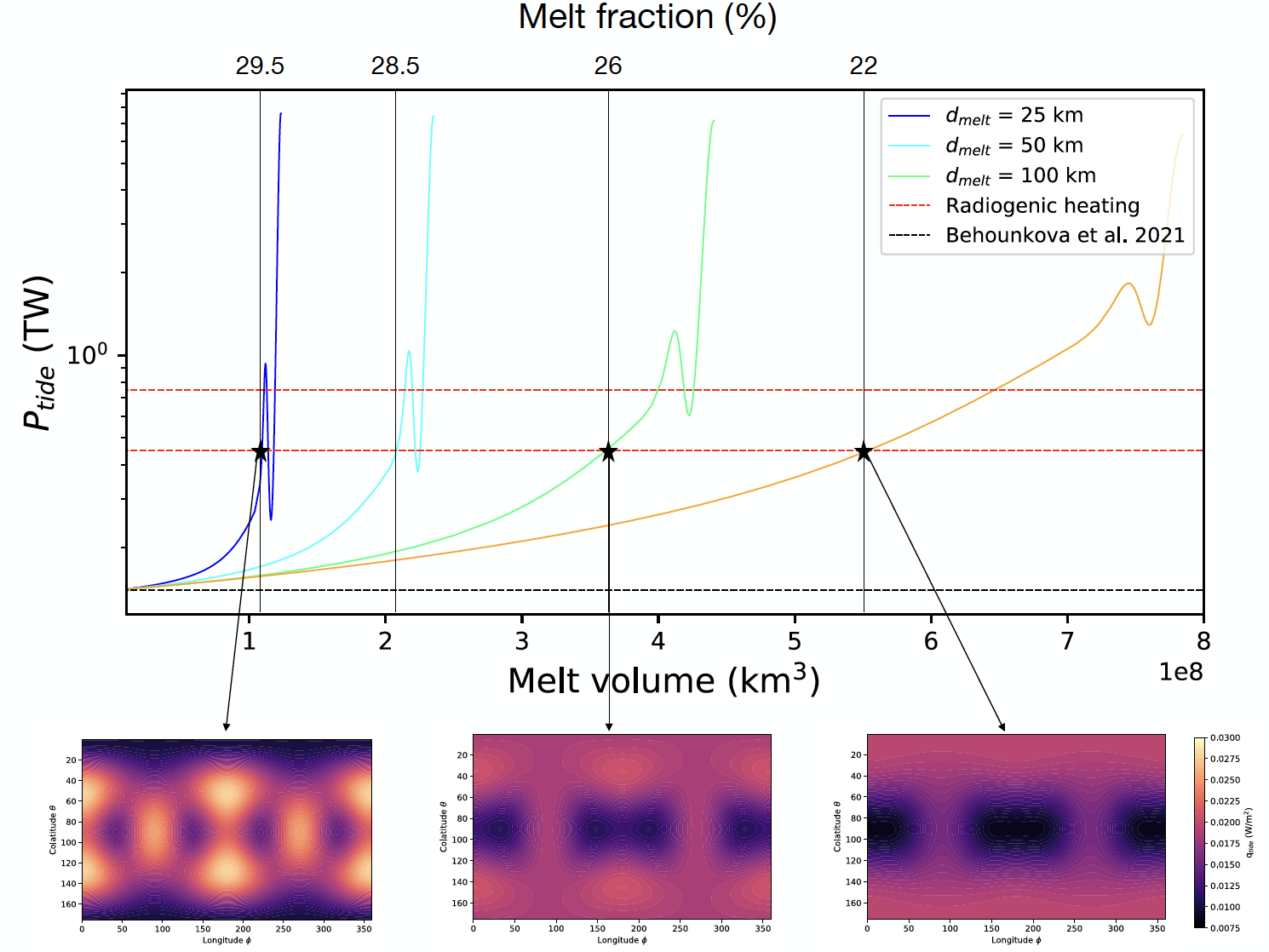Impact of melt accumulation on tidal heat production in Europa’s mantle
- 1Observatoire de Geneve, Astronomy, Switzerland (mathilde.kervazo@unige.ch)
- 2Charles University, Prague, Czech Republic
- 3Laboratoire de Planétologie et de Géodynamique, Université de Nantes, UMR-CNRS 6112
Volcanic activity at Europa’s seafloor is one of the key question regarding the habitability of its subsurface ocean. The suitable conditions for hydrothermalism on Europa’s seafloor are conditioned by the heat released from the underlying silicate mantle, either supplied by both radiogenic and tidal heating.
The orbital resonance between Io, Europa, and Ganymede forces their orbit and maintain non-zero eccentricities. As a consequence, Io, and to a lesser extent, Europa, undergo large tidal forcing during their journey around Jupiter. Because of its greater distance from Jupiter, a smaller mantle size and the decoupling effect due to the presence of the subsurface water ocean [1], mechanical energy produced by tides in Europa’s mantle is much less than that produced within Io [1, 2]. However, as demonstrated by the 3D approach of Běhounková et al. [3], the combination of tidal and radiogenic heating could maintain a partially molten state within Europa’s mantle for several tens to hundred millions of years, particularly during periods of increased eccentricity [4]. Due to inefficient melt transport through the thick lithosphere of Europa [5], melt produced during periods of enhanced eccentricity may accumulate and in turn affect the tidal heating, as it is the case for Io [e.g. 6], implying a possible runaway melt process in the silicate interior of Europa.
In this context, the goal of this study is to evaluate the effect of melt accumulation on Europa’s mantle tidal heat production, based on the predictions from the 3D simulations of Běhounková et al. [3]. For that purpose, we follow the approach developed to model the solid tides in Io’s partially molten interior [6], taking into account the effect of melt on the viscoelastic properties of the mantle. We adapt it to the context of Europa, corresponding to a deeper asthenosphere than on Io. We use the 3D model of Běhounková et al. [3] to assess in a manner consistent with mantle dynamics the depths where melting should occur as well as the production rates, which should be seen here as minimum values, and estimate the effect of melt accumulation in Europa’s mantle on local dissipation rate and re-assess the consequences in terms of global melt production rate.
Based on the production rates predicted by Běhounková et al. [3], a 100 km thick layer with a melt fraction of 20% would form in 140 million years. In order to evaluate the impact of such an accumulation zone of melt, we considered different thicknesses of partially molten layers (25, 50, 100, 200 km), plated at the base of the lithosphere, and investigate melt fraction from 0 to 30 %, corresponding to different degrees of accumulation of melt products. We show that, whatever the partially molten layer thickness, melt accumulation increase tidal heat production and even exceed radiogenic heating. For equivalent volume of accumulated melt, the thinner the layer, the more pronounced this effect is (Figure 1).
Our results show that the accumulation of melt, over timescales consistent with the 3D model prediction of Běhounková et al. [3], may significantly affect the tidal dissipation amplitude and its pattern. The potential presence fo such melt accumulations may be tested by future measurements by Europa Clipper and JUICE from the combined analysis of gravimetric, altimetric and magnetic data, which might reveal long-wavelength anomalies which could be confronted to our model prediction. Future work is, however, needed to better understand the link between melt generation and extraction in the context of Europa's mantle.

Figure 1 : Tidal power produced in Europa’s mantle with a partially molten layer of 25 (blue), 50 (cyan), 100 (green) and 200 (orange) km thickness. The expected range for radiogenic heating is represented for comparison by the red dashed lines and the black dashed line corresponds to the tidal power for no melt. The melt fraction value required in order to exceed the radiogenic power (black line) for each partially molten layer thickness is indicated, with the corresponding pattern of tidal heat flux integrated over the mantle.
[1] Tobie, G. et al., Icarus (2005).
[2] Sotin, C. et al. Europa (2009).
[3] Běhounková et al., GRL (2021).
[4] Hussmann and Spohn , Icarus (2004).
[5] Bland and Elder, GRL (2022).
[6] Kervazo et al., A&A (2021).
Acknowledgements: This research received funding from the French “Agence Nationale de Recherche” A.N.R. (OASIS project, ANR-16-CE31-0023-01,( G.T., G.C., M.K., C.D.), from CNES (JUICE and Europa Clipper missions, G.T., G.C., M.K., C.D.) and from Czech Science Foundation through project No. 22-20388S (M.B.).
How to cite: Kervazo, M., Běhounková, M., Tobie, G., Choblet, G., and Dumoulin, C.: Impact of melt accumulation on tidal heat production in Europa’s mantle , Europlanet Science Congress 2022, Granada, Spain, 18–23 Sep 2022, EPSC2022-234, https://doi.org/10.5194/epsc2022-234, 2022.

